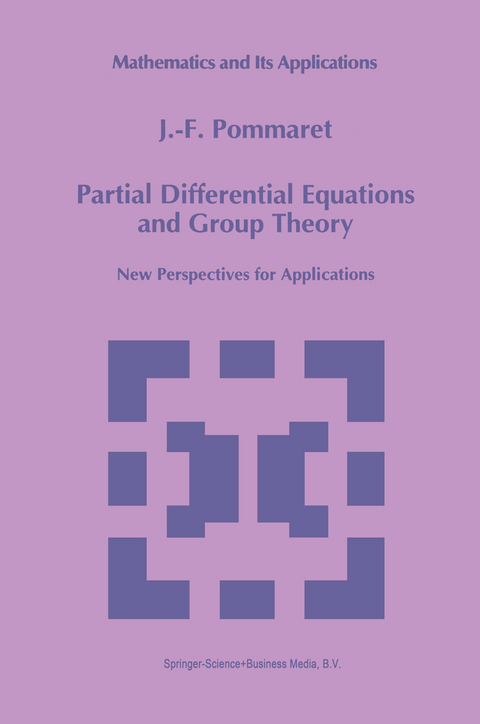
Partial Differential Equations and Group Theory
New Perspectives for Applications
Seiten
2010
|
Softcover reprint of hardcover 1st ed. 1994
Springer (Verlag)
978-90-481-4432-7 (ISBN)
Springer (Verlag)
978-90-481-4432-7 (ISBN)
Ordinary differential control thPory (the classical theory) studies input/output re lations defined by systems of ordinary differential equations (ODE). At the same time we shall unify differential geometry and differential algebra in a new framework, called differential algebraic geometry.
Ordinary differential control thPory (the classical theory) studies input/output re lations defined by systems of ordinary differential equations (ODE). The various con cepts that can be introduced (controllability, observability, invertibility, etc. ) must be tested on formal objects (matrices, vector fields, etc. ) by means of formal operations (multiplication, bracket, rank, etc. ), but without appealing to the explicit integration (search for trajectories, etc. ) of the given ODE. Many partial results have been re cently unified by means of new formal methods coming from differential geometry and differential algebra. However, certain problems (invariance, equivalence, linearization, etc. ) naturally lead to systems of partial differential equations (PDE). More generally, partial differential control theory studies input/output relations defined by systems of PDE (mechanics, thermodynamics, hydrodynamics, plasma physics, robotics, etc. ). One of the aims of this book is to extend the preceding con cepts to this new situation, where, of course, functional analysis and/or a dynamical system approach cannot be used. A link will be exhibited between this domain of applied mathematics and the famous 'Backlund problem', existing in the study of solitary waves or solitons. In particular, we shall show how the methods of differ ential elimination presented here will allow us to determine compatibility conditions on input and/or output as a better understanding of the foundations of control the ory. At the same time we shall unify differential geometry and differential algebra in a new framework, called differential algebraic geometry.
Ordinary differential control thPory (the classical theory) studies input/output re lations defined by systems of ordinary differential equations (ODE). The various con cepts that can be introduced (controllability, observability, invertibility, etc. ) must be tested on formal objects (matrices, vector fields, etc. ) by means of formal operations (multiplication, bracket, rank, etc. ), but without appealing to the explicit integration (search for trajectories, etc. ) of the given ODE. Many partial results have been re cently unified by means of new formal methods coming from differential geometry and differential algebra. However, certain problems (invariance, equivalence, linearization, etc. ) naturally lead to systems of partial differential equations (PDE). More generally, partial differential control theory studies input/output relations defined by systems of PDE (mechanics, thermodynamics, hydrodynamics, plasma physics, robotics, etc. ). One of the aims of this book is to extend the preceding con cepts to this new situation, where, of course, functional analysis and/or a dynamical system approach cannot be used. A link will be exhibited between this domain of applied mathematics and the famous 'Backlund problem', existing in the study of solitary waves or solitons. In particular, we shall show how the methods of differ ential elimination presented here will allow us to determine compatibility conditions on input and/or output as a better understanding of the foundations of control the ory. At the same time we shall unify differential geometry and differential algebra in a new framework, called differential algebraic geometry.
I. Homological Algebra.- II. Jet Theory.- III. Nonlinear Systems.- IV. Linear Systems.- V. Group Theory.- VI. Differential Galois Theory.- VII. Control Theory.- VIII. Continuum Physics.
| Erscheint lt. Verlag | 7.12.2010 |
|---|---|
| Reihe/Serie | Mathematics and Its Applications ; 293 |
| Zusatzinfo | X, 478 p. |
| Verlagsort | Dordrecht |
| Sprache | englisch |
| Maße | 155 x 235 mm |
| Themenwelt | Mathematik / Informatik ► Mathematik ► Analysis |
| Mathematik / Informatik ► Mathematik ► Geometrie / Topologie | |
| ISBN-10 | 90-481-4432-9 / 9048144329 |
| ISBN-13 | 978-90-481-4432-7 / 9789048144327 |
| Zustand | Neuware |
| Haben Sie eine Frage zum Produkt? |
Mehr entdecken
aus dem Bereich
aus dem Bereich
Buch | Softcover (2024)
De Gruyter Oldenbourg (Verlag)
59,95 €
Buch | Softcover (2024)
De Gruyter Oldenbourg (Verlag)
59,95 €


